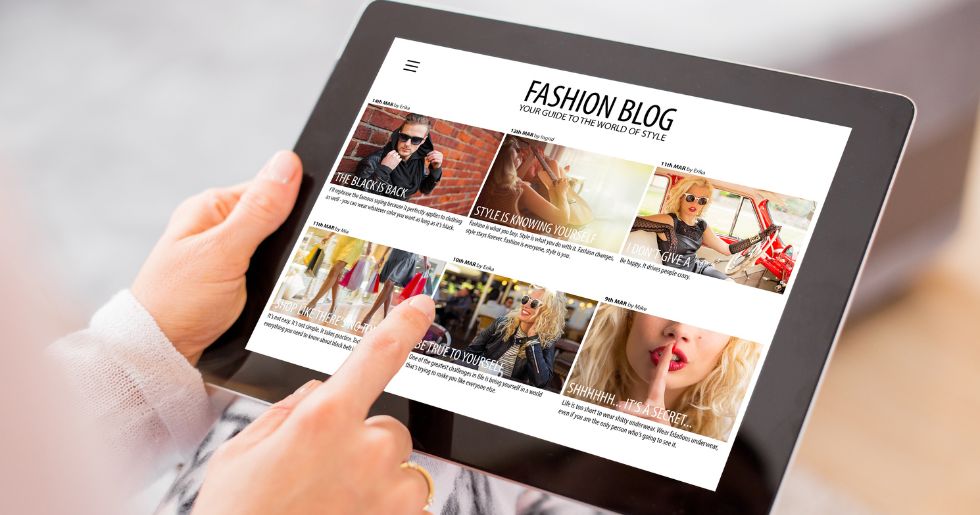Fashion blogs are an excellent platform for people who are passionate about fashion, styling, and personal expression. With the rise of social media and the growing popularity of fashion blogs, there has never been a better time to start your fashion blog. However, starting a fashion blog is just a gateway to entering the world of online shopping and the entire industry of digital fashion. Monetizing your fashion blog is the key to turning your passion into a profitable business. In this blog post, we will explore the high potential for revenue generation in fashion blogging and provide five tips for monetizing your fashion blog, including one on fashion dropshipping.

Affiliate Marketing
Affiliate marketing has emerged as a lucrative strategy for fashion bloggers looking to monetize their platforms. This method involves the blogger integrating special links to products or services within their content. The appeal of affiliate marketing lies in its performance-based nature, ensuring that bloggers are compensated proportionally to the traffic and sales they generate. Fashion bloggers, with their often large and engaged followings, are particularly well-positioned to benefit from this model. By aligning with brands that resonate with their audience’s style and preferences, bloggers can authentically promote products they believe in, enhancing their credibility and the likelihood of successful referrals. Here’s a guide to help you begin your journey in this dynamic field:
Join an Affiliate Program: Start your affiliate marketing journey by selecting a program that matches your interests or content niche, such as technology or beauty products. Joining an affiliate program is typically free and grants access to a diverse product range for promotion. Upon acceptance, you’ll receive marketing materials and product details necessary for effective promotion. This initial step is crucial as it establishes your foundation in the affiliate marketing world, providing you with the tools and support needed to start successfully promoting products.
Get Your Affiliate Links: Once you are an affiliate, the next step is to acquire unique affiliate links for each product you wish to promote. These links are vital as they help track the sales sourced from your marketing efforts. Integrating these links into your content without hampering the user experience is key. Properly placed affiliate links can dramatically influence your marketing success, ensuring that all sales referred by you are accurately recorded. To efficiently drive purchases, this phase of affiliate marketing focuses on the technical side of things, namely how to smoothly insert these links into blogs, videos, or social media postings.
Promote Products or Services: With your affiliate links in hand, you can begin promoting products across various channels like websites, social media, or email newsletters. Successful promotion rests on creating content that is both engaging and truthful, providing real value to your audience. Popular content formats include product reviews, how-to articles, and themed lists that can subtly incorporate affiliate links. Additionally, employing SEO tactics to enhance content visibility can significantly boost traffic and increase the chances of your affiliate links being clicked.
Earn Commissions: The ultimate goal of affiliate marketing is to earn commissions from the sales made through your affiliate links. Commissions are typically a percentage of the sale price, varying by program and product. Monitoring your performance via the affiliate program’s dashboard is crucial, as it offers insights into metrics such as click-through rates, conversions, and earnings. This data is invaluable for optimizing your promotional strategies and maximizing your income from affiliate marketing. Regularly analyzing and adjusting your approach based on this feedback helps enhance your effectiveness as an affiliate marketer.
By following these steps and consistently refining your approach based on performance data, you can develop a successful affiliate marketing strategy that generates a steady income over time. This model not only supports the businesses whose products you promote but also offers you a flexible and potentially lucrative online business opportunity.

Sponsored Content
This is a marketing strategy where creators produce content specifically tailored to promote a brand, product, or service in exchange for compensation. This can range from sponsored blog posts and Instagram posts to TikTok videos and YouTube content. The essence of this approach lies in the seamless integration of advertising within the content that the audience already enjoys. For instance, a travel blogger might create a post about a resort stay that was paid for by the resort’s marketing team. The goal here is to present the sponsored entity in a natural, engaging manner that doesn’t disrupt the user’s experience. This type of content is marked as sponsored or partnered to maintain transparency with the audience, ensuring ethical standards are met and trust is maintained.
Creators are often selected based on their follower demographics, engagement rates, and content style to ensure alignment with the brand’s target audience. This strategic alignment helps in creating more compelling marketing messages. For example, a tech gadget brand would benefit from partnering with a YouTuber known for in-depth tech reviews. Their audience, already interested in tech products, would find such sponsored content valuable, increasing the likelihood of positive reception and influence on purchasing decisions. The rise of data analytics tools allows brands to measure the impact of their sponsored campaigns more accurately, optimizing future strategies based on engagement rates, conversion rates, and overall ROI.
Advertising
Advertising on your fashion blog and social media channels offers a multifaceted approach to monetization, leveraging your digital presence to attract various forms of paid promotions. One primary method is through the sale of banner ads, which are strategically placed on your blog to capture the attention of readers and direct them toward advertiser websites. These ads are typically sold based on the amount of traffic your blog receives, with pricing models such as cost-per-thousand-impressions (CPM) or fixed monthly rates.
Fashion Dropshipping
Fashion dropshipping is a business model where you sell clothing or fashion items without having to hold any inventory. Instead, you partner with clothing suppliers or dropshipping clothing companies that will handle the storage, shipping, and customer service logistics for you. Here’s how to get started:
Research and Select a Reliable Supplier: The first step in establishing a fashion dropshipping business is to find a supplier who can reliably provide high-quality clothing that fits your target market. This involves researching various dropshipping companies or wholesalers and checking their product quality, reliability, and the breadth of their inventory. It’s crucial to choose a supplier that aligns with your fashion niche, whether it’s streetwear, high fashion, or eco-friendly clothing. Additionally, assess their production and shipping times to ensure they can meet customer expectations. Establishing a strong relationship with a trustworthy supplier is fundamental as their performance directly impacts your brand’s reputation.
Set Up an Online Store: Once you have your supplier in place, the next step is to create an online storefront. Platforms like Shopify provide a user-friendly interface that makes it easy to set up a shop, even for those with limited technical skills. These platforms offer various templates and tools to help you design an appealing and navigable website. When setting up your online store, focus on creating a seamless shopping experience that includes easy navigation, quick load times, and a secure checkout process. This step is vital as your website is the primary interface between you and your customers, and its functionality can significantly influence purchasing decisions.
List Your Clothing Items: With your online store ready, the next task is to populate it with products. This involves listing each clothing item you want to sell. For each product, provide detailed descriptions, including size guides, care instructions, and high-quality images that showcase the items from various angles. Accurate and enticing product descriptions can help reduce returns and increase customer satisfaction. It’s important to continuously update your product listings to reflect any changes in inventory or new trends in the fashion industry. Keeping your product listings detailed and current helps attract and retain customers by enabling them to make informed purchasing decisions.
Order Fulfillment Process: When a customer places an order through your online store, you then need to purchase the item from your supplier. This part of the process requires efficient communication and a streamlined system to ensure that orders are filled correctly and promptly. It’s essential to have a clear understanding of your supplier’s order processing times and to communicate these to your customers to manage their expectations regarding delivery.
Inventory and Shipping Management: The final step involves your supplier managing inventory, handling shipping directly to the customer, and taking care of any returns or customer service issues. This part of the dropshipping model is beneficial as it reduces your logistical responsibilities, allowing you to focus on growing your business. However, it’s important to maintain regular communication with your supplier to ensure that the inventory levels are sufficient and that the shipping standards meet your customers’ expectations.
By ensuring each part of the process is meticulously managed, you can build a successful online business that meets the needs of your customers while minimizing overhead costs. This business model not only offers flexibility and scalability but also allows entrepreneurs to tap into the vast potential of the e-commerce fashion market without the traditional barriers of entry.
This is a common way for fashion bloggers to monetize their blogs while offering a convenient shopping experience to their audience. It allows you to sell clothing items without having to hold any inventory, saving you time and money. Additionally, it provides a low-risk opportunity to start a small online clothing business.

E-Commerce
E-commerce, specifically in the context of selling fashion or lifestyle products, leverages digital platforms to facilitate direct transactions between creators and consumers. This model not only includes a wide array of products such as clothing, fashion accessories, and home decor but also extends to beauty products, wellness goods, and digital services that enhance daily living. Entrepreneurs and businesses capitalize on the growing consumer preference for online shopping, which offers convenience, a broader selection of goods, and often, competitive pricing. Moreover, e-commerce platforms enable sellers to reach a global market, overcoming geographical limitations traditionally faced by brick-and-mortar stores.
Furthermore, the digital nature of e-commerce demands robust IT infrastructure to handle website traffic, secure payment processes, and protect customer data from cyber threats. Customer service also plays a crucial role, as prompt and helpful customer support can significantly enhance customer loyalty and encourage repeat business. These operational demands necessitate skilled personnel and potentially significant technological investment, but they also offer opportunities for automation and efficiency improvements.
Advancements in technology continue to shape the e-commerce landscape, introducing new opportunities and challenges for sellers in the fashion and lifestyle domains. Artificial intelligence (AI) and machine learning are increasingly employed to personalize shopping experiences, predict trends, and optimize inventory. Augmented reality (AR) and virtual reality (VR) technologies are being utilized to create innovative shopping experiences, such as virtual try-ons for clothes or visualization of furniture in real home settings, enhancing customer engagement and satisfaction.
To establish an e-commerce business, you need to formulate a business plan for online boutique that includes a market analysis, product offerings, and a marketing strategy. Then, set up an online store using an online shop builder, such as Shopify, and commence selling your products. E-commerce allows you to monetize your fashion blog while providing your audience with a unique shopping experience. By selling your products, you have full control over the quality, design, and pricing. It offers a chance to construct your brand and broaden your revenue sources.
Fashion blogs have a high potential for revenue generation, and there are several monetization methods to choose from, including affiliate marketing, sponsored content, advertising, fashion dropshipping, and e-commerce. By incorporating these tips into your fashion blog, you can turn your passion for fashion into a profitable business. Start by creating a business plan for your online boutique and exploring the monetization methods that are best suited to your goals and audience.
